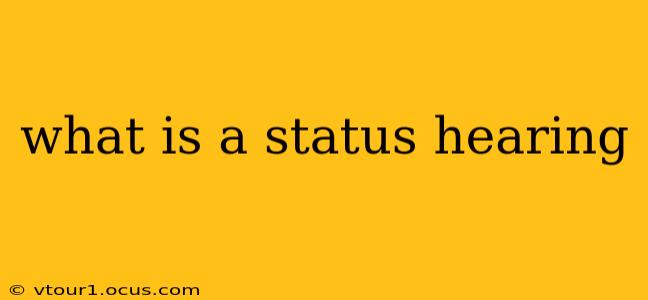A status hearing, also sometimes called a case management conference, is a relatively brief meeting between the parties involved in a legal case and the judge. It's not a trial; it's a check-in to assess the progress of the case and identify any potential roadblocks. Think of it as a progress report for the court. The primary goal is to keep the case moving efficiently towards resolution.
This guide will delve into the specifics of status hearings, addressing common questions and providing a clear understanding of their purpose and process.
What Happens During a Status Hearing?
The content of a status hearing varies depending on the specific case and jurisdiction. However, common elements include:
- Review of the Case's Progress: The judge will inquire about the steps taken since the last hearing or filing. This includes the completion of discovery (the exchange of information between parties), the filing of motions, and any other significant developments.
- Discussion of Outstanding Issues: The parties will discuss any remaining issues that need to be addressed. This might involve scheduling depositions, expert witness testimony, or setting a trial date.
- Setting Deadlines: The judge will often set deadlines for completing specific tasks, such as filing briefs or responding to motions. Missing these deadlines can have significant consequences.
- Conflict Resolution: Status hearings can provide an opportunity for the judge to help resolve disputes between the parties, potentially avoiding more extensive court proceedings.
- Addressing Procedural Matters: The hearing might address procedural matters, such as amending pleadings or clarifying court orders.
What is the Purpose of a Status Hearing?
The main purposes of a status hearing are:
- Case Management: To ensure the efficient and timely management of the case.
- Early Dispute Resolution: To identify and potentially resolve disputes early in the process, potentially leading to settlement.
- Judicial Oversight: To provide judicial oversight of the case's progress and ensure compliance with court rules and deadlines.
- Cost-Effectiveness: To avoid unnecessary delays and costs associated with lengthy litigation.
Who Attends a Status Hearing?
Typically, the following individuals attend a status hearing:
- The Judge: The presiding judge in the case.
- Attorneys for Each Party: Representatives for each party involved in the litigation.
- Sometimes, Parties Themselves: While less common, parties involved may be required to attend, particularly in cases involving personal injury or family law.
How Long Does a Status Hearing Last?
Status hearings are usually relatively short, often lasting anywhere from 15 minutes to an hour. The length depends on the complexity of the case and the number of outstanding issues to be addressed.
What if I Miss a Status Hearing?
Missing a status hearing can have serious consequences. It could result in sanctions from the court, such as fines or even dismissal of your case. It’s crucial to attend all scheduled hearings.
Do I Need a Lawyer for a Status Hearing?
While not always mandatory, it's highly recommended to have legal representation at a status hearing. An attorney can effectively advocate for your interests, ensure compliance with court procedures, and protect your rights.
What is the Difference Between a Status Hearing and a Trial?
A status hearing is a preliminary procedural step, focused on managing the case's progress. A trial, on the other hand, is the formal presentation of evidence and arguments to the court to determine the outcome of the case. A status hearing does not involve presenting evidence or witnesses.
Can a Status Hearing Result in a Settlement?
While not the primary purpose, a status hearing can sometimes lead to a settlement. The judge may facilitate discussions between the parties, encouraging them to reach a mutually agreeable resolution.
This comprehensive guide aims to provide a clear understanding of status hearings. Remember to always consult with an attorney for specific legal advice related to your individual case.
